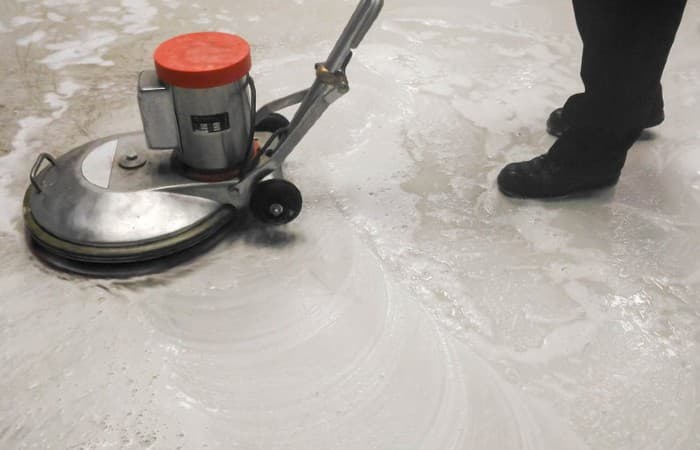
Learning the best methods to clean a garage floor effectively is a DIY skill that is high on most home improvement lists. A dirty-looking garage floor can be an eyesore and it’s not always easy to clean due to the porous nature of concrete. Stains, rust, oil, and other contaminants can sometimes be hard to remove.
Properly cleaning the concrete is a critical step if you are prepping the garage floor for paint, epoxy, or sealers as well. As a result, we will discuss the leading techniques you can use to get your concrete garage floor clean.
The most effective low-budget method for cleaning a garage floor is to use a hose with a high-pressure nozzle, a concrete degreaser, a deck brush, and some good old-fashioned elbow grease.
In addition, we include our recommendations for the most effective degreasing solutions for concrete. We also discuss the use of pressure washers, which equipment is most effective for scrubbing dirty concrete, and how to remove mastic, old paint, and sealers from the garage floor.
If your goal is to eliminate pet urine odor and stains, then we have a separate article here that discusses how to do that.
This post may contain affiliate links. If you use these links to make a purchase, we may earn a small commission. As an Amazon Associate, All Garage Floors earns from qualifying purchases. You can read our full disclaimer here.
Steps for Cleaning Concrete Garage Floors
The required steps for cleaning garage floors are fairly straightforward. However, different scrubbing methods or particular cleaning solutions may be needed depending on how dirty the concrete is.
As a result, we discuss these steps in detail in order to achieve the best success.
1. Remove all items from the garage floor
The first thing you need to do is remove everything from the floor that is not anchored down. Next, sweep up all the heavy dirt and debris.
As obvious as this seems, taking shortcuts or eliminating steps only makes the job more difficult and less successful.
If you have drywall in the garage, you may want to cover the lower 3ft. with cheap plastic drop cloths. Just tape them in place. You can find them at your local home improvement center for just a few dollars. It’s also a good idea to cover up any low electrical outlets with tape if you are not using a drop cloth.
2. Soak the concrete with a degreaser/cleaning solution
It is important to soak the concrete with a cleaning solution or degreaser. This allows time for the solution to penetrate the concrete and go to work at loosening up dirt and oils.
The solution should dwell for a minimum of 5 minutes. Do not let it dry out. Use hot water if the cleaning solution allows for it. It’s best to work in 10’ square sections and not soak the entire floor at once. Otherwise, your solution may dry out.
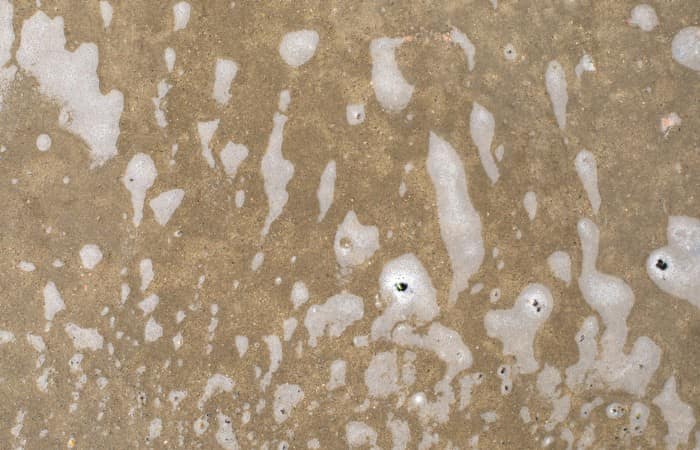
Some concrete surfaces can be more dense or smooth and it may take a few minutes for the solution to soak in. Unless the concrete is not very dirty, scrubbing immediately will not be as effective.
We list our recommended concrete cleaning solutions and degreasers here below.
3. Scrub or Pressure Wash the Concrete
Once the cleaning solution or degreaser has soaked, add a little more solution and begin scrubbing the concrete. The scrubbing action helps to dig the dirt and grease out of the concrete pores.
In addition, the scrubbing helps the cleaning solution to emulsify the contaminants and keep them in suspension before rinsing.
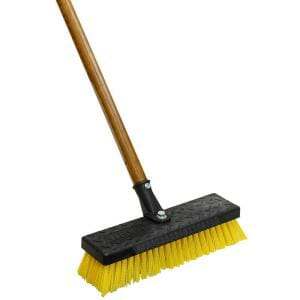
We recommend using a short bristled deck brush for scrubbing. They are very effective and the stiff bristles can withstand the pressure required.
You can find them here at Amazon or your local home improvement center.
Tip: Push brooms are a poor scrub brush. The bristles are too long and the surface area is too large to apply good pressure.
If you have a pressure washer, you can use it at this point instead of scrubbing. We discuss more the use of pressure washers in the Equipment section below.
Do not use a steel wire brush! The steel particles of the brush can transfer dark marks onto the concrete that are difficult to remove. In addition, the scrubbing action of the steel wire bristles will change the texture of the concrete surface and create a permanent blemish.
4. Rinse the Garage Floor
Do not let the solution you are scrubbing with dry out before you rinse it away. Otherwise, the dirt, grease, and other contaminants that are emulsified and lifted out with the cleaning solution will settle back into the concrete.
Use a high-pressure nozzle on your hose for rinsing if you can. The higher pressure does a good job of blasting out any dirt and debris that may have settled back into the pores of the concrete. It also aids in moving out the water faster.
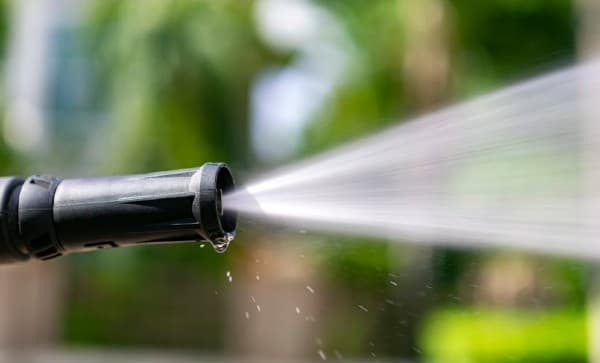
You find high-pressure nozzles fairly inexpensively from your local home improvement center or here from Amazon.
Make sure to rinse the solution from the clean section out of the garage or off the concrete. If not, it can settle back into a dirty section of concrete and just make your work more difficult. Once it is rinsed out, move on to the next dirty section of concrete.
If you have a wet vac, they work very well for sucking the dirty water and debris out of the concrete pores. You still need to rinse afterward to remove any cleaning residue.
Once the floor dries you should have a very clean concrete surface. You can now inspect it for any areas that need to be spot cleaned.
Grease, oil stains, rust, or other contaminants are an example that we will discuss shortly.
Optional Cleaning Equipment for a Garage Floor
Concrete is porous and can become fairly embedded with dirt and grime over the years if it hasn’t been cleaned very often. If you are dealing with a floor such as this, then you do have some equipment options that can make the job easier and more effective.
The right concrete cleaning equipment can be successful at getting the dirtiest of garage floors clean.
The first of these is a pressure washer. Pressure washers can save time and labor in scrubbing and excel at cleaning concrete. Most will allow you to add a degreaser to a chemical tank for additional cleaning action.
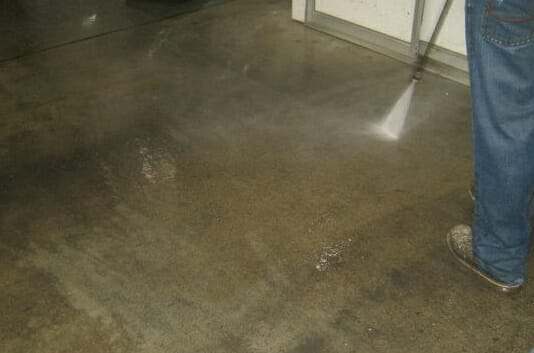
They are not very expensive to rent from your local home improvement center or local equipment rental facility. For the most effective cleaning, a minimum 2800 – 3000 PSI pressure washer with a water flow rate of 3 gallons per minute or more works best.
Use a yellow 15-degree fan tip. For particularly stubborn areas such as stains, you can use the more powerful turbo tip.
Be careful not to linger too long in one area when using a good pressure washer and keep the tip moving. The water action is so abrasive you can actually etch the surface of the concrete if you are not careful.
Read: How to Clean Garage Floors with a Pressure Washer
The newer rotary surface cleaner attachments for pressure washers have become very popular due to how effective they can be. They keep overspray at a minimum and do a good job of cleaning the concrete.
It’s important to match the rotary attachment with the correct pressure requirements. Here is an excellent example from Amazon.
The second equipment option you can use is a floor maintainer with a nylon scrubbing head for concrete. You can rent these as well.
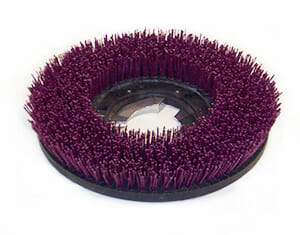
Be sure to tell the rental company that you will need a nylon brush attachment for cleaning concrete. They are sometimes called a Malish brush, referring to the brand name Malish.
Use the floor maintainer during the scrubbing step. Take your time as you go and let the machine do the work.
You may have to add a little water as you scrub to keep the solution wet and sudsy.
Both pressure washers and floor maintainers can do wonders. It’s not unusual for the concrete to turn a few shades lighter after using them.
Recommended Concrete Degreasers and Cleaning Solutions
For most concrete cleaning jobs, an alkaline soap or degreaser should be used. Alkaline cleaners work best for breaking down and emulsifying oils, grease, and other hydrocarbon-based contaminants and stains that are normally found in concrete.
Alkaline cleaners will range from 8 – 14 on the pH scale. Most concrete cleaners and degreasers will have a pH of 11 or greater.
Acidic-based concrete cleaners should not be used in most circumstances. They work poorly at removing grease, oils, and other hydrocarbons found on garage floors. Oil and acid are two dissimilar chemicals that will separate into layers, just as water and oil do.
Instead, acidic cleaners should be used for the removal of efflorescence, rust, and salts. We will discuss the specific use of acidic concrete cleaners shortly.
Alkaline Concrete Degreasers
TSP – Short for trisodium phosphate, TSP has a pH of 12 – 14. It is a strong alkaline cleaner that is extremely effective for cleaning dirty concrete. It performs fair on oil stains, but there are better alternatives for oil if that is your main goal.
Use 1/4 cup of TSP to one gallon of warm/hot water for light cleaning. Use 1/2 cup of TSP for heavy-duty cleaning.
Care should be taken when using TSP. It is exceptionally alkaline and can cause skin irritation and even burns. Gloves and eyewear are recommended.
Laundry detergent – That’s right, laundry detergent is alkaline and can be fairly effective. It typically performs well for concrete that is not extremely dirty and without moderate to heavy oil stains.
Avoid laundry detergents that have a pH below 10. Tide is one such example.
Our recommended laundry detergent is Arm & Hammer. It has a pH of 11.5 – 12.2. Any particular type will work. We recommend 1/3 cup of detergent to one gallon of hot water.
Concrete Degreasers – Degreasers for concrete and driveways are our top choice for cleaning a garage floor that has oil and grease stains. They range from 11 – 12 on the pH scale.
Unlike TSP or laundry detergents, concrete degreasers use various biodegradable solvents and alcohol to help break down and dissolve oil and other hydrocarbons in water. This includes keeping them in suspension longer so that they can be rinsed away.
Most concrete degreasers are concentrates so it’s important to follow the instructions. Warm water helps, but do not use hot water. It tends to make degreasers too foamy.
Oil Eater and Purple Power are our top 2 recommendations. These are always our “Go to” favorites when cleaning concrete. Both have excellent reviews. You can find Oil Eater here from Amazon and Purple Power here from Amazon.
Cleaning Oil Stains and Grease
With the heavy cleaning done, you can now spot-clean any remaining oil or grease stains that need more work. Concrete degreasers are what you should start with.
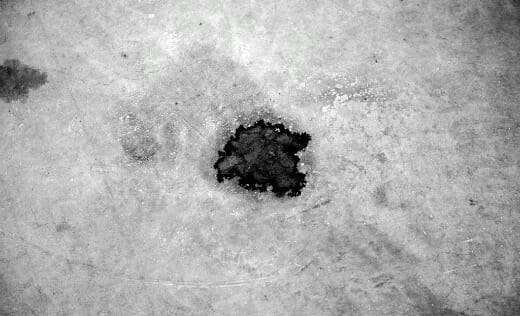
Wet the stain and surrounding area first. Apply the degreaser to the oil spot at full concentrated strength. The reason for wetting first is to prevent the contaminants in the stain from spreading to a clean dry area.
Scrub the degreaser into the concrete and let it dwell for 10 minutes. While it sits, prepare a strong solution of degreaser that is mixed at 3 parts degreaser to one part water. The water is required to help the solvents in the degreaser to dissolve and draw out the oils into suspension before rinsing.
When ready, add the strong 3 to 1 solution to the area and scrub again. Once done scrubbing, rinse the area well.
If you don’t have a concrete degreaser on hand or you are dealing with some particularly stubborn or old oil stains, then there are more advanced methods for removing oil stains.
Read: How to Remove Oil and Grease Stains from Concrete
Be advised that older stains that have been in the concrete for a long time may still have some discoloration, even after the oil is removed.
How to remove rust stains
There are a few effective ways to remove rust stains from your garage floor. This is one of the circumstances where an acidic-based cleaner works best.
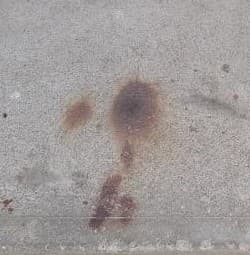
For light rust spots, you can use either lemons or white vinegar. The acid-base in lemons and vinegar helps to dissolve the rust.
Squeeze the lemons or pour the white vinegar over the stain and let it sit for 5 minutes or so. Add some more lemon juice or vinegar and then scrub with a good stiff brush. Rinse well with water and repeat if necessary.
Oxalic acid is a product that works better on tougher rust stains. You can generally purchase it from your local home improvement center or here on Amazon.
Some concrete cleaners for rust stains have it as an ingredient. It may even come in a powder form which you mix with water to make a soupy paste.
Apply the Oxalic acid to the rust stain and let it sit for 5 minutes before scrubbing. Be sure to rinse well afterward. Again, repeat if necessary.
Another option is to use one of the concrete rust stain removers that are available over the counter. You can see a whole list of these products here at Amazon.
Tip: A brass wire brush is effective for scrubbing rust. It will not transfer metal marks to the concrete and is less aggressive than a steel wire brush. We like this one here.
For the toughest of rust stains, a mild solution of muriatic acid will work wonders. However, you need to be careful when using it. We suggest a ratio of 8 parts water to 1 part acid to start. More isn’t always better in this regard unless you are preparing your concrete for a floor coating.
Read: How to Acid Etch a Garage Floor
If you mix it too strong right away it will aggressively etch the concrete. This can make the area look different from the surrounding concrete. In addition, it makes the surface rougher by opening up the concrete pores. This will allow dirt to embed easier and make it harder to clean.
Danger: Do not pour water into acid – pour the acid into the water instead. Pouring water directly into acid can cause it to explode into a gas that can splash in your face. Wear gloves and eye protection when using acid.
How to remove efflorescence from your garage floor
Efflorescence consists of insoluble metallic salts that look like a white powdery substance or residue on the concrete surface of garage floors. It develops when moisture from below the concrete works its way to the surface.
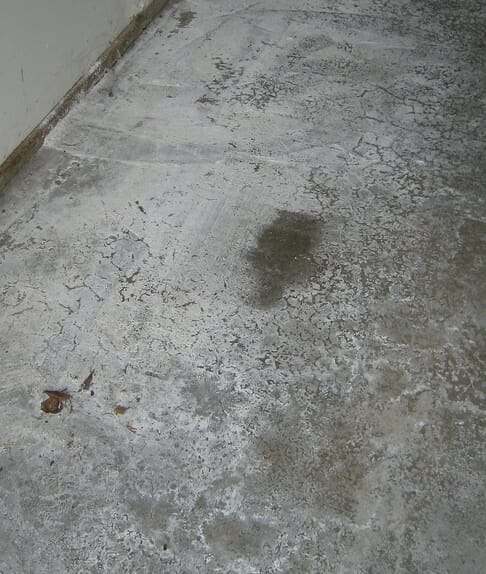
The moisture picks up these salts and minerals along the way and deposits them on the surface when the moisture evaporates. Standard cleaning solutions are not effective.
Instead, an acidic-based cleaning solution needs to be used. The acidic cleaners react with the concrete minerals and salt to dissolve them.
There are nontoxic biodegradable efflorescence removers that can be used. We recommend trying them first. They are essentially mild citric acid etching solutions.
Once applied, let the solution dwell for the required time. Agitation or mild scrubbing with a nylon deck brush helps with the removal process.
Our favorite is Eco-Etch Pro. It is more aggressive at removing efflorescence. Plus, it’s safe to use and will not require that the concrete be neutralized when you are done.
If an efflorescence remover does not remove it all, then the next step is to use a muriatic acid etch. We recommend starting with a solution of 6 parts water to 1 part muriatic acid. Do not use anything stronger than a 3 to 1 ratio. Doing so will severely etch and change the look of the surface.
Important: If you are not using an Eco-safe acidic solution, then you need to neutralize the concrete afterward. This returns the concrete to its natural alkaline state.
An alkaline cleaning solution works well to neutralize concrete. Just apply it to the area, let it dwell for a few minutes with some light agitation, and then rinse off with clean water.
Removing old paint, mastic, and sealers
If you are applying a coating to your floor, you will need to remove any type of residue on the surface such as a topical sealer, old paint, or mastic. This needs to be done first before any attempt is made at cleaning. There are two different methods you can use depending upon what is on the concrete.
The first would be the use of a chemical stripper. We highly recommend a couple of products by Franmar. They are environmentally friendly and work exceedingly well.
For mastic removal, we recommend Blue Bear 500MR Mastic Remover. It is very effective as long as you give it the time it needs to work.
For removing coatings, paint, acrylics, and old sealers, we recommend Blue Bear 605 Pro Multipurpose Coating Remover.
Eco-friendly strippers like these are more expensive than solvent strippers. They also require more time to work (chemically, not physically). In addition, they are much safer for you and the environment.
The other method for removing mastic, paint, and sealers is to grind the concrete. Special grinding heads are available depending upon what needs to be removed.
This process does require less elbow grease than chemical strippers, but it is more expensive. You can read more about using floor grinders for concrete here.
Final Cleaning Tips
One tool that can come in handy for larger garages is a floor squeegee. These work great at moving large volumes of water out of the garage quickly. If you don’t have a squeegee, a push broom will work. You can find floor squeegees here at Amazon.
If you are acid etching your concrete in preparation for paint or an epoxy coating, then you still must clean your garage floor as described above. Acid works by breaking down the surface of the concrete to expose the pores. It is not effective at cleaning away dirt or removing oil as we explained earlier.
If you plan on grinding your garage floor, then you only need to clean heavily soiled areas and spot clean the oil stains. Any other light surface contaminants such as efflorescence or rust stains will clean up with the grinding.
If followed correctly, you will find that these methods for cleaning a garage floor are highly effective. We know this is generally thought of as the least desirable job of any flooring project. However, once done it will reward you with a nice clean concrete floor that is free of dirt and stains.

Is it safe to use acetone to clean a concrete garage floor that has been saturated with car chemicals for the last 30 years with no attempt to ever clean a spill?
Hello Tony. Acetone helps to emulsify oils in order to lift them from a surface. It needs to be used in conjunction with a poultice in order to absorb oils. This article on cleaning oil stains explains how the process works. Acetone does not clean concrete like a degreaser. Always make sure there are no open flames when using large quantities of acetone before covering with a poultice. We always recommend degreasing the concrete first by scrubbing or pressure washing methods first before using acetone for cleaning stubborn areas.
Be careful in garage if you have your water heater (gas pilot) in there. Flammable cleaning agents/fumes, boom! Bad.
Concrete poured a month ago. I have coffee and wheels marks from scaffolding. It’s getting cold. 1 celcius over night. It’s 1400 sqft. I would like to seal and then add some thing we get snow winter could be 6 months.
Help
Hi Sharon. For new concrete with marks, try scrubbing the area with some white vinegar and steel wool. The vinegar acts as a very mild acid solution. What do you mean exactly that you would like to add something after you seal the concrete?
Hi ok clean with vinegar. Does this need water to wash away or does the total floor need washed before applying a sealer and what sealer is best in these conditions cold long winters?
Clean the marks with the white vinegar and rinse afterwards. After that, you will need to clean the entire concrete surface and let it dry before applying a sealer. You can use one of the methods above. For sealing, we recommend using a densifier with a siliconate sealer added. This one here is one we recommend.
I have an Old, large brake fluid stain in the concrete. I tried a degreaser and it worked a little bit I then soaked a towel in the diluted degreaser and let it soak over night. Is this safe for the concrete?
Hi Brenton. No, it won’t hurt the concrete.
I want to remove paint spray and dirt from a garage floor (3 car garage). I nhave a 3000 psi pressure washer in oreoaration for staining and sealing. I know a degreaser works for grease, but what works well for removing large areas of over-sprayed paint. Also can I add a concrete stain to Rutland water glass concrete sealer so the product is laid down only once, rather than first the stain and then the sealer. Thank you.
Hello Roberta. Many times a pressure washer alone will remove the overspray. If that doesn’t work, a floor maintainer with a black scrub pad will usually do the trick. No, you cannot add stain to that sealer. You need to apply the concrete stain to the concrete first and then the sealer. True concrete stains can only be applied direct to concrete. FYI, the sealer you mentioned is not a durable sealer for a garage floor if you plan on parking cars on it.
Love this website and the information provided. Quick question – I am going to be grinding my garage floor before using Nohr-S Polyurea. Do I need to clean and degrease the floor or will the grinding take care of it for me? I have some light paint splatter, some grease, and a gas stain or two. Otherwise the concrete is in good shape. Thanks again!
Hi Matthew. Degrease first the areas where you have any gas, grease, or oil stains. You want to pull the contaminant out of the concrete as best you can. Don’t worry about paint splatter as the grinding will take that off quick. Just a quick sweep of loose dirt after that. Once done grinding, make sure to do a water drop test in the areas where the stains were. The concrete should immediately turn darker and absorb the water in less than a minute.
Our concrete garage floor is about 5 years old. It has become slippery and we are concerned about falls. We park our car in the garage regularly in the winter and we think the salt from the snow and the wet from the tires has contributed to the slipperiness. I recently tried baking powder and vinegar and there was some improvement but I don’t think I scrubbed hard or long enough. I plan on buying one of the push brooms you recommend. What type of solution or product do you recommend before I attempt this again? Should I try TSP? Thank you very much for your guidance.
Hello Linda. TSP is an excellent cleaner for concrete. The salt and any deicing fluids that collect on the surface should not contribute to the floor being slippery. In fact, the exact opposite usually happens. Salts and deicing fluids contribute to the deterioration of the concrete surface and make the surface less smooth. Once you get it clean, we would recommend applying a sealer to the surface to protect it. They are inexpensive and easy to apply. Here is one example we can recommend. In addition, you can protect the garage floor and help prevent it from getting wet by using a containment mat in the wintertime. We discuss them here.
Hi Shea. Thank you very much for this response. This is exactly the type of information I was hoping for. Wondering if you can recommend one or two other sealers that might be more available as I live in Ontario, Canada and could not find this product through Amazon. Something similar that is easy to apply would be perfect. Thanks again.
Hi Linda. If you can purchase GhostShield, then we recommend the Silox-Tek 8500. Prosoco is another brand that has distributors in Canada. We would recommend their Consolideck LS.
Thank you very much. Will look into both of them. Much appreciated.
Linda
Hi Shea,
We have a 40-year-old two car garage concrete floor(added Silpro TDQ to cover slight aggregate areas) and want to paint grey and add protection from salt etc from winter snow melting from 1 car. we live in New England. I’d like to rent a diamond tipped sander to really clean and open up pores of concrete than put down appropriate chemicals and stain etc. What steps/products would you recommend getting best results including avoiding the paint from coming up due to hot tires?
Thanks a lot,
Greg
Hi Greg. Can you clarify a couple of things? I’m not quite sure what you mean about the chemicals and stain. Are you looking for a quality coating product that looks great and will stand up to your New England winters and protect the concrete?
Hello, we have a brand new 2,400 square foot shop with a concrete floor. We are past the cure time and are wanting to seal it. We have ordered the PS100 with the Densifier. We are trying to clean the floor, but they ran the 8,000 pound telehandler on the concrete, leaving tire marks. We haven’t been able to get the tire marks out, trying our pressure washer as well as Purple Power. Any suggestions would be much appreciated.
Hi Jesse. Ugh… we hate when that happens. Pressure washers alone aren’t always effective for removing tire marks. Scrubbing is usually what’s needed. Also, Purple Power is higher on the alkaline scale with a pH between 11 and 12. This helps with grease and oil, but not necessarily as well with tire marks. We suggest testing it against a cleaner that is less alkaline such as Simple Green. It has pH of 9 and may cut into the tire marks better. Apply a solution of each to an area and let it dwell for minute. Scrub and then rinse. Hopefully that will do it. If you have a lot of tire marks, then you may want to rent a floor maintainer with a green scrub pad to do the scrubbing for you. Just keep in mind that the more aggressive you get with your cleaning the more those areas may look different than the rest of the floor.
Thanks so much for the suggestions, we will give them a try and hope for the best!